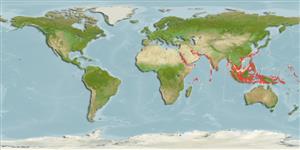ກຸ່ມປາກະດູກອ່ອນ (ເຊັ່ນ: ປາສະຫລາມ, ປາຜາໄລ) (sharks and rays) >
Carcharhiniformes (Ground sharks) >
Hemigaleidae (Weasel sharks)
Etymology: Chaenogaleus: chaeno-, from chaino (Gr.), gape, referring to “rictus as long as wide”; galeos, a small shark or dogfish per Aristotle (sometimes translated as weasel, hence the name Weasel Sharks, possibly referring to the pointed snouts, swift movements and/or rapacious feeding behavior of smaller predatory sharks1), but in this case probably an allusion to Hemigaleus, original genus of C. macrostoma. (See ETYFish); macrostoma: macro-, from makros (Gr.), large or long; stoma (Gr.), mouth, referring to long, greatly arched mouth compared with Hemigaleus microstoma, its presumed congener at the time. (See ETYFish).
More on author: Bleeker.
Environment: milieu / climate zone / depth range / distribution range
ນິເວດວິທະຍາ
ສັດທະເລ ອາໄສຢູ່ໃກ້ໜ້າດິນໃຕ້ພື້ນທ້ອງນ້ຳ; ລະດັບຄວາມເລິກ ? - 59 m (Ref. 244). Tropical; 30°N - 10°S
Indo-West Pacific: Persian Gulf (Ref. 13567), Pakistan, India, Sri Lanka, Singapore, Thailand, Viet Nam, China, Taiwan, Java and Sulawesi in Indonesia. This name has been used indiscriminately for the three species of hemigaleids in Indo-Pakistani waters other than Hemipristis elongatus.
Length at first maturity / ຂະໜາດ / ນ້ຳໜັກ / Age
Maturity: Lm 82.5, range 68 - 97 cm
Max length : 100.0 cm TL ຕົວຜູ້/ບໍ່ມີເພດ; (Ref. 244)
ຄີ (ໜາມ)ແຂງຢູ່ຫຼັງປາ (ທັງໝົດ) : 0; ຄີ(ໜາມ) ແຂງຢູ່ຄີກົ້ນປາ
ກຸ່ມປາກະດູກແຂງ
ຄວາມຖີ່ຂອງກຸ່ມຖ່າຍທອດພັນ
ປາທີ່ມີການເຄື່ອນຍ້າຍຈາກທະເລໄປຫານ້ຳຈືດ ແລະນ້ຳຈືດຫາທະເລ
ປາທີ່ມີການເຄື່ອນຍ້າຍຈາກທະເລແລະໄປໄຂ່ຢູ່ນ້ຳຈືດ
ຄີກົ້ນຂອງປາ
ສັດທີ່ມີກະດູກສັນຫັຼງ
ການຖ່າຍທອດທາງກຳມະພັນຈາກພໍ່ແມ່ຫາລູກ: 0. Bronzy-grey above, white below when fresh, fading to greyish or greyish brown in preservation, dorsal fins often with dusky or black tips (Ref. 13567).
A common inshore and offshore shark found on the continental and insular shelves (Ref. 13567). Probably feeds on small fishes, cephalopods, and crustaceans (Ref. 244). Viviparous (Ref. 50449). Caught irregularly by inshore gillnet fisheries and occasionally by small-scale longlining (Ref.58048). Probably taken by artisanal fisheries wherever it occurs (Ref. 13567). Utilized fresh for human consumption and by-products processed into fishmeal (Ref. 244).
Viviparous (with a yolk-sac placenta), with 4 young in a litter (Ref. 244). Size at birth at least 20 cm (Ref. 244). Distinct pairing with embrace (Ref. 205).
Compagno, L.J.V., 1984. FAO Species Catalogue. Vol. 4. Sharks of the world. An annotated and illustrated catalogue of shark species known to date. Part 2 - Carcharhiniformes. FAO Fish. Synop. 125(4/2):251-655. Rome: FAO. (Ref. 244)
IUCN Red List Status (Ref. 130435)
Human uses
ການປະມົງ: ທີ່ເປັນການຄ້າໜ້ອຍ
ເຄື່ອງມື
Special reports
Download XML
ແຫຼ່ງອີນເຕີເນັດ
Estimates based on models
Preferred temperature (Ref.
123201): 25 - 29.3, mean 28.4 °C (based on 1082 cells).
Phylogenetic diversity index (Ref.
82804): PD
50 = 1.0039 [Uniqueness, from 0.5 = low to 2.0 = high].
Bayesian length-weight: a=0.00324 (0.00223 - 0.00470), b=3.02 (2.92 - 3.12), in cm total length, based on LWR estimates for this species (Ref.
93245).
ຊັ້ນເຂດຮ້ອນ (Ref.
69278): 4.2 ±0.57 se; based on food items.
ຄວາມຢືດຢຸ່ນ (Ref.
120179): ຕຳ່ຫຼາຍ, ປະຊາກອນຕຳ່ສຸດທີ່ໃຊ້ເວລາສອງເທົ່າຫຼາຍກວ່າ 14 ປີ (Fec=4).
Fishing Vulnerability (Ref.
59153): High vulnerability (60 of 100).
